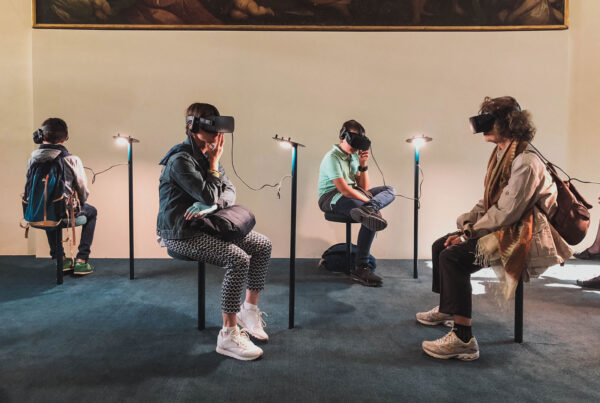Virtual Reality is a buzzword that has been around for years. The technology has seen many improvements over the last decade, and film virtual reality is one of the newest advancements in this field.
There are major differences between film VR to 3D VR, so it’s important to understand how each medium works before you make a decision on which type of experience you want for your next project. In film VR, real-world content is captured via film recording or 360-degree videos. 3D VR, unlike film VR, does not use real-world camera footage but instead is based on a 3D computer-generated environment.
In this article, we’ll take a look at some of the most significant differences between these two types of virtual reality experiences and which type might be best suited for your project.
What Is Film VR?

The camera footage used in film VR consists of real-world scenes that are seamlessly edited so that the viewer has the ability to experience them in virtual reality. The differences between film and 3D VR production start with their unique production methods and challenges. It takes specialist applications to edit 360-degree video footage–some which are commercially available and some which users have to edit themselves. Most virtual reality films place the viewer in a stationary spot and limit their range of motion.
Film VR is popular because it can be produced quickly and cheaply, with minimal special effects. It is also a lot easier to create for film VR because the viewer is stationary.
Types of Film VR
Film-based virtual reality gives the viewer a more immersive but less interactive experience than traditional 3D virtual reality. In the case of real-estate developments, potential buyers could see the structure from a perspective but not interact with it. Film virtual reality (VR) is an exciting new development in the world of storytelling and film. There are different types of film virtual reality, namely Live-Action 3D Video and 3D 360 degree video.
Types:
– Live-Action 3D video, also known as stereoscopic 3D technology that can be viewed on a normal screen; this type of VR has made it possible for filmmakers to put viewers right in the middle of an event or moment without having to be physically present. This technique requires two cameras to capture footage from different angles at once.
– 3D 360-degree video is filmed with a tablet, smartphone or camera that has two lenses as well. The major difference between this type of film VR and live-action VR is that it is meant to be viewed at a later stage in time and not while the event is happening.
Different Uses: film virtual reality can be used as marketing tools for movies and events such as premieres and conferences; it also can be used to film concerts and parties. It can be a good way for companies to show new products or take clients on tours of their facilities without having to give them private access at all times.

What is 3D Virtual Reality?
3D computer graphics enable the creation of imaginative or nonreal content, typically rendered in real-time from a game engine. Creating content in 3D requires the data to adhere to real-world values, such as scale and proportion.

Instead of cameras, the 3D artist will need to digital re-create the environment using 3D modeling and texturing techniques. The advantages of 3D virtual reality are the ability to film from any angle and the creation of animations or games with 360-degree views. A disadvantage is that it requires a more lengthy production process than traditional filmmaking techniques.
Game developers can often get away with cheats when building their 3D objects by allowing the player to see only what they need to see. Whereas in virtual reality, a viewer is typically free of constraints. So the entire 3D object also must be properly modeled and textured to produce a convincing experience from all viewing angles.
Virtual reality has gained more traction as a result of its interactive nature. It’s also significantly more expensive to create in comparison to film VR and can take many months for production, so you need a hefty budget if you want high-quality 3D virtual reality content–and that price tag doesn’t include renting out equipment.
Types of 3D Virtual Reality
Types:
- fully immersive VR, whereby the user wears a head-mounted display (HMD) to view digital content; this type of technology can also include input devices such as gloves or bodysuits.
- mobile-based VR, in which the user’s phone is inserted into a headset or held up to their eyes.
- Augmented Reality, this type of VR overlays 3D computer-generated graphics on top of physical objects.

Different Uses: 3D VR is a great format for immersive interactive storytelling, games, and training simulations.
The Industry Applications of 3D VR
-For training simulation in the workplace it is a great way to teach employees new skills without putting them at risk when they are outside of work–and this helps with retention rates too.
- In education, virtual reality can be used to simulate environments to help train students.
- In architecture, 3D VR can be used to design and walk through buildings before they are built in the real world.
Some of the Major Downsides: There is a large upfront investment as well as an ongoing financial commitment for integrating new tools into your workflows; there is also still some debate as to how affordable 3D VR will be for consumers.
In order to use virtual reality, a company or user needs to purchase equipment like headsets (Oculus Rift and HTC Vive), computer hardware as well as cameras and sensors that track motion controllers – this can get expensive fast.
Is 3D VR Better than Film VR?
It’s hard to say. 3D VR has its strengths in that it can be more immersive and interactive than film, while at the same time being able to generate environments not possible with films like sounds and RPCs.
Film is still a great tool for storytelling because of how accessible it is – consumers don’t need expensive equipment or hours of training to be able to watch a film.
3D VR is more immersive and interactive than film but can be expensive to create compared to film. So if you’ve got a tight budget for your project, you should most probably stick to film VR.
On the other hand, if you and your team want to go all-in on offering a virtual reality experience for your project, then full immersive VR is going to be for you.
In my opinion, film VR should not count as real VR because it lacks the interactivity and immersion that makes VR, VR.
But each to their own, and film VR can also be a great option if your target market might not have the technical confidence to put on a headset and play around in a virtual environment with controllers.
So, which one do you think is best for your industry and why? Let me know down in the comments!







